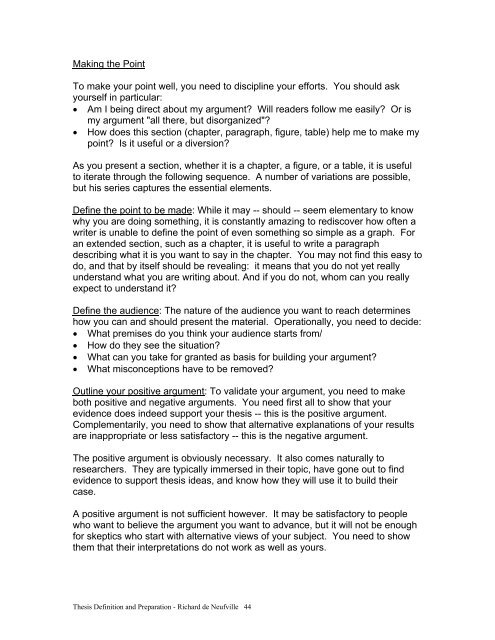Richard de Neufville's TPP SM Thesis Manual - Title Page - MIT
Richard de Neufville's TPP SM Thesis Manual - Title Page - MIT
Richard de Neufville's TPP SM Thesis Manual - Title Page - MIT
- No tags were found...
Create successful ePaper yourself
Turn your PDF publications into a flip-book with our unique Google optimized e-Paper software.
Making the PointTo make your point well, you need to discipline your efforts. You should askyourself in particular:• Am I being direct about my argument? Will rea<strong>de</strong>rs follow me easily? Or ismy argument "all there, but disorganized"?• How does this section (chapter, paragraph, figure, table) help me to make mypoint? Is it useful or a diversion?As you present a section, whether it is a chapter, a figure, or a table, it is usefulto iterate through the following sequence. A number of variations are possible,but his series captures the essential elements.Define the point to be ma<strong>de</strong>: While it may -- should -- seem elementary to knowwhy you are doing something, it is constantly amazing to rediscover how often awriter is unable to <strong>de</strong>fine the point of even something so simple as a graph. Foran exten<strong>de</strong>d section, such as a chapter, it is useful to write a paragraph<strong>de</strong>scribing what it is you want to say in the chapter. You may not find this easy todo, and that by itself should be revealing: it means that you do not yet reallyun<strong>de</strong>rstand what you are writing about. And if you do not, whom can you reallyexpect to un<strong>de</strong>rstand it?Define the audience: The nature of the audience you want to reach <strong>de</strong>termineshow you can and should present the material. Operationally, you need to <strong>de</strong>ci<strong>de</strong>:• What premises do you think your audience starts from/• How do they see the situation?• What can you take for granted as basis for building your argument?• What misconceptions have to be removed?Outline your positive argument: To validate your argument, you need to makeboth positive and negative arguments. You need first all to show that yourevi<strong>de</strong>nce does in<strong>de</strong>ed support your thesis -- this is the positive argument.Complementarily, you need to show that alternative explanations of your resultsare inappropriate or less satisfactory -- this is the negative argument.The positive argument is obviously necessary. It also comes naturally toresearchers. They are typically immersed in their topic, have gone out to fin<strong>de</strong>vi<strong>de</strong>nce to support thesis i<strong>de</strong>as, and know how they will use it to build theircase.A positive argument is not sufficient however. It may be satisfactory to peoplewho want to believe the argument you want to advance, but it will not be enoughfor skeptics who start with alternative views of your subject. You need to showthem that their interpretations do not work as well as yours.<strong>Thesis</strong> Definition and Preparation - <strong>Richard</strong> <strong>de</strong> Neufville 44
















